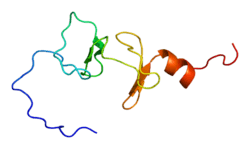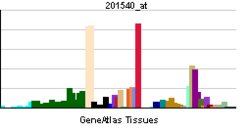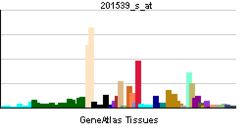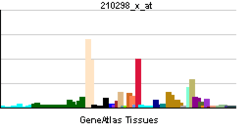FHL1
Four and a half LIM domains protein 1 is a protein that in humans is encoded by the FHL1 gene.[1][2][3]
LIM proteins, named for 'LIN11, ISL1, and MEC3,' are defined by the possession of a highly conserved double zinc finger motif called the LIM domain.[supplied by OMIM][3]
Role in muscle disorders
FHL1 has been shown to be heavily expressed in skeletal and cardiac muscles.[4] In 2008 this was borne out by the discovery that defects in the FHL1 gene are responsible for a number of Muscular dystrophy-like muscle disorders, ranging from severe, childhood onset diseases through to adult-onset disorders similar to Limb girdle muscular dystrophy. At present different research groups are using different terminology for these disorders, which include:
- X-linked myopathy with postural muscle atrophy (XMPMA)
- [5] An adult-onset muscle disorder known to affect families in Austria and the UK.
- Reducing body myopathy (RBM)
- [6] A rare disorder causing progressive muscular weakness characterized by aggresome-like inclusions in the myofibrils. The effects of the disorder can be either severe, with onset of weakness at approximately five years, or adult onset, with weakness occurring in the late 20s, early 30s.
- Scapuloperoneal (SP) syndrome
- [7] Another adult-onset muscle disorder, especially affecting the shoulder girdle and legs.
References
- ↑ Morgan MJ, Madgwick AJ (Oct 1996). "Slim defines a novel family of LIM-proteins expressed in skeletal muscle". Biochem Biophys Res Commun 225 (2): 632–8. doi:10.1006/bbrc.1996.1222. PMID 8753811.
- ↑ Lee SM, Tsui SK, Chan KK, Garcia-Barcelo M, Waye MM, Fung KP, Liew CC, Lee CY (Oct 1998). "Chromosomal mapping, tissue distribution and cDNA sequence of four-and-a-half LIM domain protein 1 (FHL1)". Gene 216 (1): 163–70. doi:10.1016/S0378-1119(98)00302-3. PMID 9714789.
- ↑ 3.0 3.1 "Entrez Gene: FHL1 four and a half LIM domains 1".
- ↑ Lee SM; Tsui SK; Chan KK et al. (1998). "Chromosomal mapping, tissue distribution and cDNA sequence of four-and-a-half LIM domain protein 1 (FHL1)". Gene 216 (1): 163–70. doi:10.1016/S0378-1119(98)00302-3. PMID 9714789.
- ↑ Windpassinger C; Schoser B; Straub V et al. (January 2008). "An X-Linked Myopathy with Postural Muscle Atrophy and Generalized Hypertrophy, Termed XMPMA, Is Caused by Mutations in FHL1". American Journal of Human Genetics 82 (1): 88–99. doi:10.1016/j.ajhg.2007.09.004. PMC 2253986. PMID 18179888. ,
- ↑ Schessl J; Zou Y; McGrath MJ et al. (March 2008). "Proteomic identification of FHL1 as the protein mutated in human reducing body myopathy". The Journal of Clinical Investigation 118 (3): 904–12. doi:10.1172/JCI34450. PMC 2242623. PMID 18274675.
- ↑ Quinzii CM; Vu TH; Min KC et al. (January 2008). "X-Linked Dominant Scapuloperoneal Myopathy Is Due to a Mutation in the Gene Encoding Four-and-a-Half-LIM Protein 1". American Journal of Human Genetics 82 (1): 208–13. doi:10.1016/j.ajhg.2007.09.013. PMC 2253963. PMID 18179901.
Further reading
- Morgan MJ; Madgwick AJ; Charleston B et al. (1995). "The developmental regulation of a novel muscle LIM-protein". Biochem. Biophys. Res. Commun. 212 (3): 840–6. doi:10.1006/bbrc.1995.2045. PMID 7626119.
- Maruyama K, Sugano S (1994). "Oligo-capping: a simple method to replace the cap structure of eukaryotic mRNAs with oligoribonucleotides". Gene 138 (1–2): 171–4. doi:10.1016/0378-1119(94)90802-8. PMID 8125298.
- Suzuki Y; Yoshitomo-Nakagawa K; Maruyama K et al. (1997). "Construction and characterization of a full length-enriched and a 5'-end-enriched cDNA library". Gene 200 (1–2): 149–56. doi:10.1016/S0378-1119(97)00411-3. PMID 9373149.
- Tani S; Taniwaki M; Taniguchi Y et al. (1999). "Chromosomal mapping of two RBP-J-related genes: Kyo-T and RBP-L". J. Hum. Genet. 44 (1): 73–5. doi:10.1007/s100380050112. PMID 9929984.
- Morgan MJ, Madgwick AJ (1999). "The LIM proteins FHL1 and FHL3 are expressed differently in skeletal muscle". Biochem. Biophys. Res. Commun. 255 (2): 245–50. doi:10.1006/bbrc.1999.0179. PMID 10049693.
- Greene WK, Baker E, Rabbitts TH, Kees UR (1999). "Genomic structure, tissue expression and chromosomal location of the LIM-only gene, SLIM1". Gene 232 (2): 203–7. doi:10.1016/S0378-1119(99)00125-0. PMID 10352231.
- Brown S; McGrath MJ; Ooms LM et al. (1999). "Characterization of two isoforms of the skeletal muscle LIM protein 1, SLIM1. Localization of SLIM1 at focal adhesions and the isoform slimmer in the nucleus of myoblasts and cytoplasm of myotubes suggests distinct roles in the cytoskeleton and in nuclear-cytoplasmic communication". J. Biol. Chem. 274 (38): 27083–91. doi:10.1074/jbc.274.38.27083. PMID 10480922.
- Lee SM; Li HY; Ng EK et al. (1999). "Characterization of a brain-specific nuclear LIM domain protein (FHL1B) which is an alternatively spliced variant of FHL1". Gene 237 (1): 253–63. doi:10.1016/S0378-1119(99)00251-6. PMID 10524257.
- Ng EK; Lee SM; Li HY et al. (2001). "Characterization of tissue-specific LIM domain protein (FHL1C) which is an alternatively spliced isoform of a human LIM-only protein (FHL1)". J. Cell. Biochem. 82 (1): 1–10. doi:10.1002/jcb.1110. PMID 11400158.
- Lange S; Auerbach D; McLoughlin P et al. (2003). "Subcellular targeting of metabolic enzymes to titin in heart muscle may be mediated by DRAL/FHL-2". J. Cell. Sci. 115 (Pt 24): 4925–36. doi:10.1242/jcs.00181. PMID 12432079.
- Strausberg RL; Feingold EA; Grouse LH et al. (2003). "Generation and initial analysis of more than 15,000 full-length human and mouse cDNA sequences". Proc. Natl. Acad. Sci. U.S.A. 99 (26): 16899–903. doi:10.1073/pnas.242603899. PMC 139241. PMID 12477932.
- Gevaert K; Goethals M; Martens L et al. (2004). "Exploring proteomes and analyzing protein processing by mass spectrometric identification of sorted N-terminal peptides". Nat. Biotechnol. 21 (5): 566–9. doi:10.1038/nbt810. PMID 12665801.
- McGrath MJ; Mitchell CA; Coghill ID et al. (2004). "Skeletal muscle LIM protein 1 (SLIM1/FHL1) induces alpha 5 beta 1-integrin-dependent myocyte elongation". Am. J. Physiol., Cell Physiol. 285 (6): C1513–26. doi:10.1152/ajpcell.00207.2003. PMID 12917103.
- Ota T; Suzuki Y; Nishikawa T et al. (2004). "Complete sequencing and characterization of 21,243 full-length human cDNAs". Nat. Genet. 36 (1): 40–5. doi:10.1038/ng1285. PMID 14702039.
- Qin H; Wang J; Liang Y et al. (2004). "RING1 inhibits transactivation of RBP-J by Notch through interaction with LIM protein KyoT2". Nucleic Acids Res. 32 (4): 1492–501. doi:10.1093/nar/gkh295. PMC 390284. PMID 14999091.
- Gerhard DS; Wagner L; Feingold EA et al. (2004). "The Status, Quality, and Expansion of the NIH Full-Length cDNA Project: The Mammalian Gene Collection (MGC)". Genome Res. 14 (10B): 2121–7. doi:10.1101/gr.2596504. PMC 528928. PMID 15489334.
- Philippar U; Schratt G; Dieterich C et al. (2005). "The SRF target gene Fhl2 antagonizes RhoA/MAL-dependent activation of SRF". Mol. Cell 16 (6): 867–80. doi:10.1016/j.molcel.2004.11.039. PMID 15610731.
- Qin H; Du D; Zhu Y et al. (2005). "The PcG protein HPC2 inhibits RBP-J-mediated transcription by interacting with LIM protein KyoT2". FEBS Lett. 579 (5): 1220–6. doi:10.1016/j.febslet.2005.01.022. PMID 15710417.
| |||||||||||||
External links
- GeneReviews/NCBI/NIH/UW entry on Emery-Dreifuss muscular dystrophy
- FHL1 protein, human at the US National Library of Medicine Medical Subject Headings (MeSH)
This article incorporates text from the United States National Library of Medicine, which is in the public domain.
| ||||||||||||||||||||||||||||||||||||||||||||||||||||||||||||||||||||||||||||||||||||||||||||||||||||||||||||||||||||||||||||||||||||||||||||||||||||||||||||||||||||||||||||||||||||||||||||||||||||||||||||||






